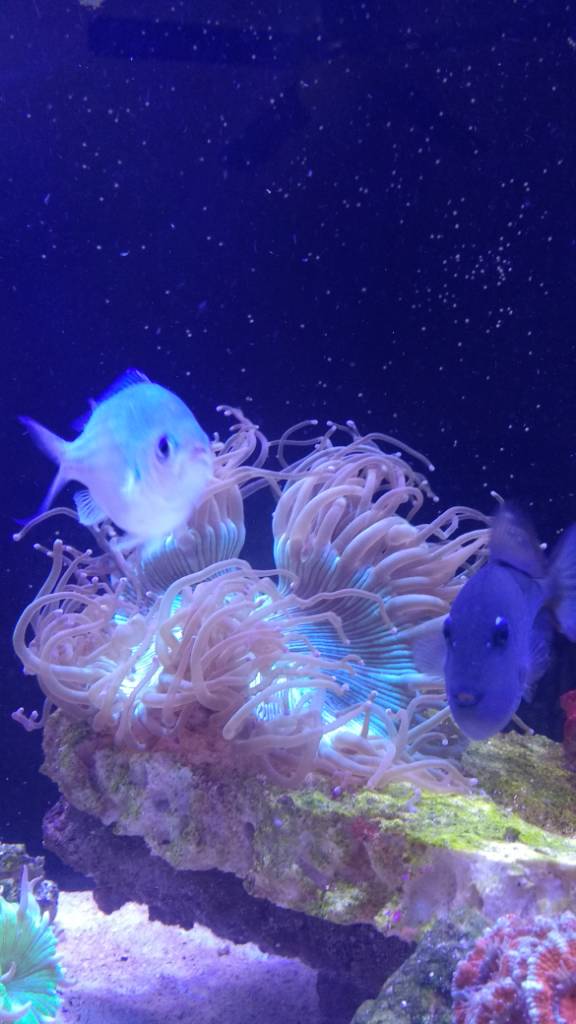Thirty years ago, when I had my first reef aquarium, I bought one (and only one) Elegance, and it lived for the entire 4 years I had that tank. Started off large and grew even larger, over 16" expanded, and it stayed expanded all the time, greedily grabbing bits of food and stuffing them into its multiple mouths. It was amazing.
But then I had to then leave the hobby, for work reasons. I just got back into it. A lot has changed, mostly for the better. I've had a 100g tank set up for about 6 months, keeping many animals successfully (so far) that would have been nearly impossible back then. But I'm already on my third elegance, which is dying just like the last two.


This is pretty obviously ECS, a condition I had not heard of when I bought the first Elegance for this tank. In fact nobody at the local store mentioned it either, they were more than happy to sell me the coral. It wasn't until the second supposedly hardier one from Australia also took ill and died for no good reason that I actually did some online research and quickly encountered this miserable condition. The third (currently dying) one is supposedly Australian too. Articles on ECS (particularly Borneman 2008) suggest that this malady is due to an environmentally persistent infectious agent. However, as Borneman himself points out, he did not culture a specific organism and then produce the same disease in a healthy coral by infecting it with that organism. Without doing this (satisfying Koch's Postulates), all the evidence, even his microscopic findings, is just circumstantial and could be secondary infection. I mean, this disease could even be viral, and you won't prove that without sophisticated isolation and culture techniques.
So my question is this - Is there ANY progress being made with this condition? Do we have any more knowledge than we did 9 years ago? New information on the causative organism? Are we even sure it's infectious, could it be an undetected toxin? Any effective treatment? Role of other factors, like lighting and water flow? Duration of environmental persistence of the causative agent in the absence of elegance corals?
I suspect the answer to all of these questions still is: We don't know. Googling it brings up little. Searching this forum, the last time someone asked about this, there were no responses at all. But it's worth a shot asking again. That last question, in particular, would be nice to have answered, for those of us who might one day want to keep this gorgeous coral again.
But then I had to then leave the hobby, for work reasons. I just got back into it. A lot has changed, mostly for the better. I've had a 100g tank set up for about 6 months, keeping many animals successfully (so far) that would have been nearly impossible back then. But I'm already on my third elegance, which is dying just like the last two.
This is pretty obviously ECS, a condition I had not heard of when I bought the first Elegance for this tank. In fact nobody at the local store mentioned it either, they were more than happy to sell me the coral. It wasn't until the second supposedly hardier one from Australia also took ill and died for no good reason that I actually did some online research and quickly encountered this miserable condition. The third (currently dying) one is supposedly Australian too. Articles on ECS (particularly Borneman 2008) suggest that this malady is due to an environmentally persistent infectious agent. However, as Borneman himself points out, he did not culture a specific organism and then produce the same disease in a healthy coral by infecting it with that organism. Without doing this (satisfying Koch's Postulates), all the evidence, even his microscopic findings, is just circumstantial and could be secondary infection. I mean, this disease could even be viral, and you won't prove that without sophisticated isolation and culture techniques.
So my question is this - Is there ANY progress being made with this condition? Do we have any more knowledge than we did 9 years ago? New information on the causative organism? Are we even sure it's infectious, could it be an undetected toxin? Any effective treatment? Role of other factors, like lighting and water flow? Duration of environmental persistence of the causative agent in the absence of elegance corals?
I suspect the answer to all of these questions still is: We don't know. Googling it brings up little. Searching this forum, the last time someone asked about this, there were no responses at all. But it's worth a shot asking again. That last question, in particular, would be nice to have answered, for those of us who might one day want to keep this gorgeous coral again.



















